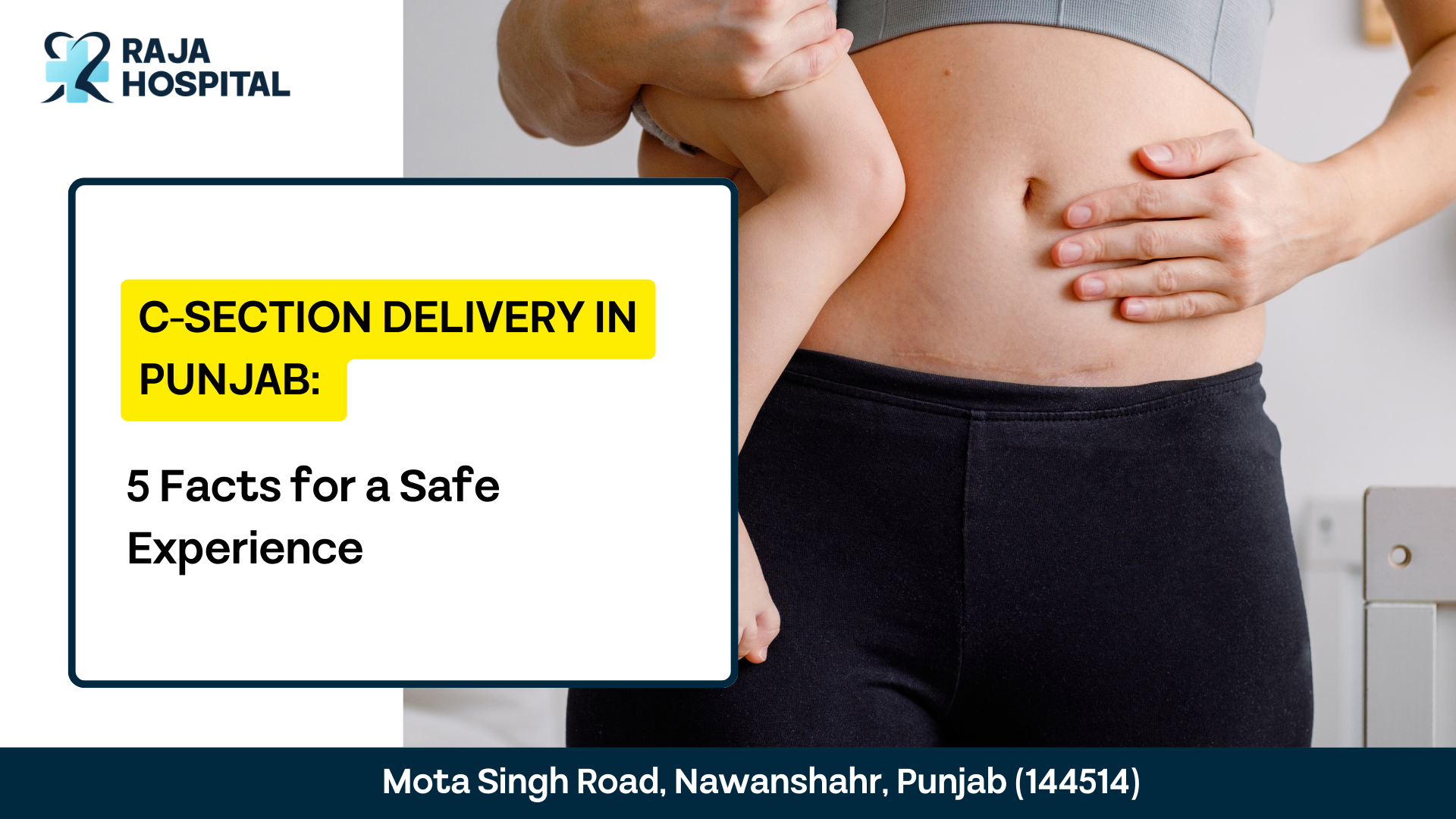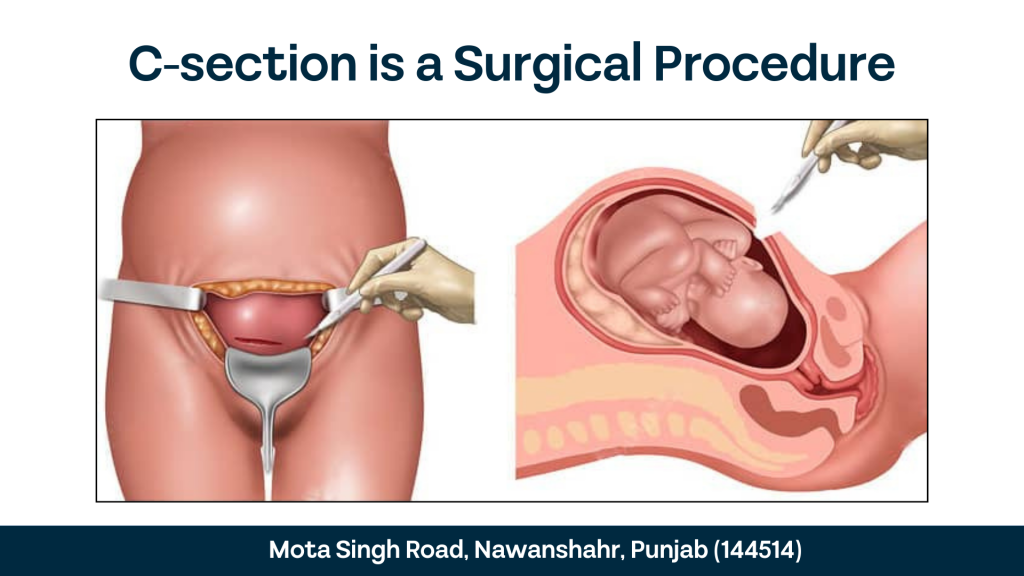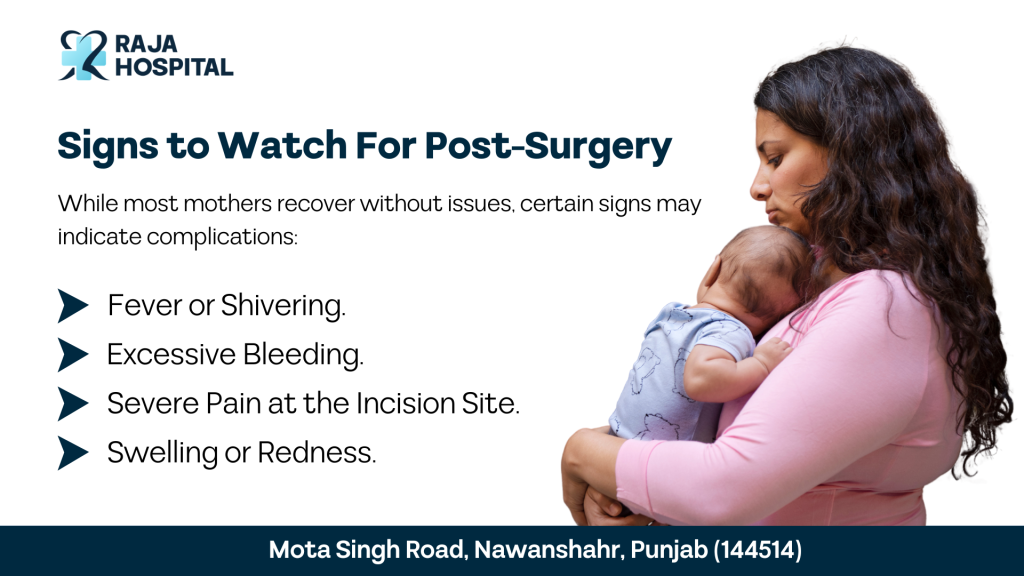C-Section Delivery in Punjab: 5 Facts for a Safe Experience

REVIEWED BY DR. LAKSHITA SAINI (MBBS, MS OBS & GYNAE) ON 17th October 2024
Bringing a baby into the world is one of the most beautiful and life-changing experiences. However, sometimes things don’t go exactly as planned, and a C-section (Cesarean delivery) becomes the best option for the health and safety of both mom and baby.
You might have a lot of questions right now—Will it be painful?How long will it take to recover?Is it safe for my baby? You’ve likely heard all sorts of things—maybe some myths about unbearable recoveries or worries that a C-section could affect future pregnancies.
But here’s some good news: with today’s medical advances, C-sections are safer than ever. Many of those myths you’ve heard? They’re just that—myths. Let’s walk through what a C-section really involves, when it might be necessary, and how Raja Hospital provides outstanding care to make sure both you and your baby are in the best hands possible.
What Exactly Is a C-Section?

In simple terms, a C-section is a surgical procedure used to deliver a baby. Instead of a vaginal delivery, the baby is delivered through small incisions made in the mother’s abdomen and uterus. Sometimes this becomes the best, or only, option for a variety of reasons, and it’s all about ensuring both you and your baby stay safe and healthy.
You might be wondering, “When is a C-section necessary?” Let’s talk about that next.
Struggling with same?
Book Your Appointment With Our Expert Doctors

When Do Doctors Recommend a C-Section?
Doctors only recommend a C-section when they believe it’s the safest option. Here are some common reasons why:
- Breech Position: If your baby is feet or bottom-first instead of head-first.
- Multiple Births: Twins, triplets, or more babies may make a vaginal delivery more complicated.
- Placenta Previa: When the placenta blocks the cervix, it can be dangerous for vaginal delivery.
- Fetal Distress: If your baby shows signs of distress, like an irregular heartbeat during labor, a C-section ensures a faster, safer delivery.
- Labor Complications: Sometimes labor doesn’t progress as it should, or the baby’s size poses risks for a vaginal birth.
- Previous C-Section: While you can have a vaginal birth after a C-section (known as VBAC), some moms might need another C-section depending on their health.
Every pregnancy is unique, and your doctor will make the recommendation based on what’s safest for you and your baby.
Why Choose Raja Hospital for C-Section Delivery?

We understand that the idea of surgery can be daunting. But at Raja Hospital, our goal is to make your experience as smooth, safe, and comfortable as possible. Here’s why families choose us for their C-sections:
- Experienced Obstetricians: Our skilled team ensures you and your baby are in excellent hands.
- State-of-the-Art Facilities: We use the latest technology to ensure the safest procedures.
- Comprehensive Care: From the first consultation to post-surgery recovery, we’re with you every step of the way.
- Personalized Birth Plans: We respect your wishes and work with you to create a birthing experience that fits your needs.
- 24/7 Neonatal Care: Should your baby need any extra care, our neonatal team is available around the clock.
What Happens During a C-Section? Let’s Break It Down.

Pain. Anxiety. Uncertainty. These are natural emotions when thinking about any form of surgery, especially when it involves your child.
We understand that knowing what’s coming can ease a lot of anxiety. Here’s what you can expect on the day of your C-section:
1. Pre-Surgery Consultation
You’ll meet with your obstetrician to go over all the details of the procedure. This is your time to ask any questions! We’ll review your medical history, discuss risks, and give you instructions on how to prepare—like any fasting or medication requirements.
(Illustration)
- Detailed medical history review.
- Explanation of the procedure and any associated risks.
- Instructions for pre-surgery fasting and medications.
2. In the Operating Room
- You’ll be taken to the operating room and made comfortable.
- We’ll clean and prep your abdomen for surgery.
- Once you’re ready, the surgeon will make a small incision in your lower abdomen and uterus, and your baby will be delivered. This part is usually quick—about 10 minutes.
- After your baby is born, we’ll cut the umbilical cord and provide immediate care, while your incisions are stitched up.
3. Anesthesia & Monitoring
Don’t worry—you won’t feel any pain during the procedure. Typically, you’ll have either spinal or epidural anesthesia, which numbs the lower half of your body but keeps you awake so you can meet your baby right away. Throughout the procedure, our team will closely monitor both your vital signs and your baby’s health.
Recovering From a C-Section: What to Expect
Recovery after a C-section is different from a vaginal delivery, but with the right care, you’ll heal and be back on your feet in no time.
Here’s a quick guide on what the recovery process looks like:
- First 1-3 Days: You’ll need plenty of rest. Don’t be afraid to ask for help—our medical team is here to make sure you’re comfortable and healing well.
- 1-2 Weeks Post-Surgery: Light movement and walking are actually encouraged, as this helps with blood circulation and healing.
- 6-8 Weeks: Full recovery typically takes about this long, but make sure you check in with your doctor before resuming any heavy physical activity.
- Stay Hydrated and Eat Well: Your body is healing from surgery, so make sure you’re drinking plenty of water and eating nutrient-rich foods to support recovery.
- Follow Your Doctor’s Advice: Stick to your follow-up appointments and prescribed care.
Are There Any Risks with C-Sections?
Like any surgery, a C-section comes with some risks, though they are rare. It’s important to be aware of potential complications so you know what to look out for:
- Infections: This can happen at the incision site or in the uterus.
- Blood Clots: The risk of blood clots increases after surgery, but your doctors will monitor for this.
- Breathing Issues for Newborns: Babies born via C-section may have a slightly higher chance of breathing problems, but these are usually temporary.

Q&A
Conclusion
Welcoming a new baby into the world is an incredible journey, and whether your path includes a C-section or a vaginal delivery, the most important thing is that you feel informed, supported, and confident every step of the way.
We’ve walked through everything from what a C-section involves to why it may be necessary, and what you can expect during recovery.
Ready to learn more or take the next step? Reach out to us today to schedule your consultation and discuss your birth plan. At Raja Hospital, you’re never alone on this life-changing journey—together, we’ll make sure both you and your baby are in the best hands.
